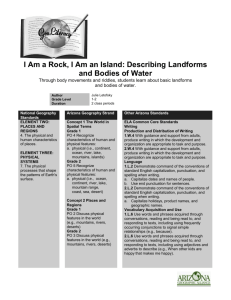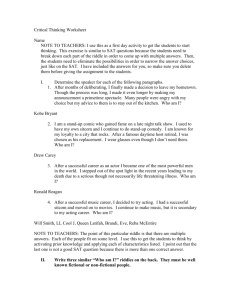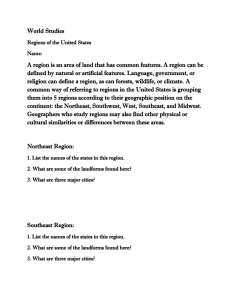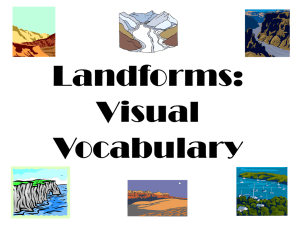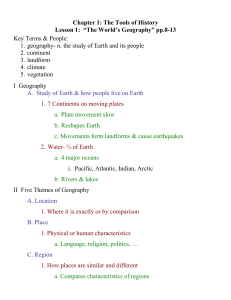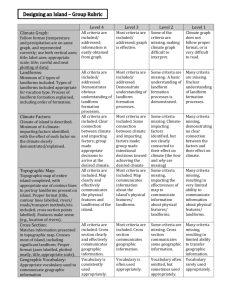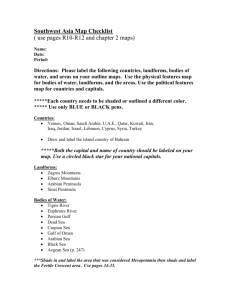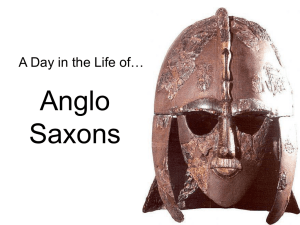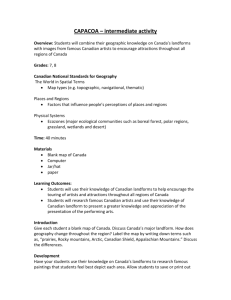Describing Landforms and Bodies of Water
advertisement
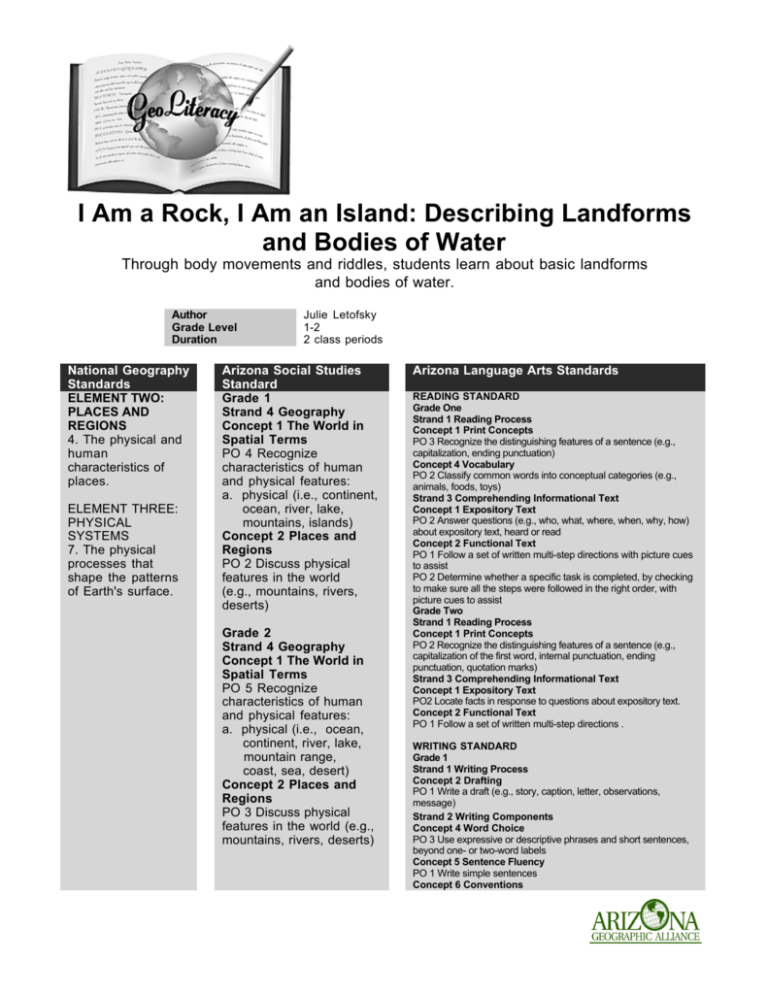
I Am a Rock, I Am an Island: Describing Landforms and Bodies of Water Through body movements and riddles, students learn about basic landforms and bodies of water. Author Grade Level Duration National Geography Standards ELEMENT TWO: PLACES AND REGIONS 4. The physical and human characteristics of places. ELEMENT THREE: PHYSICAL SYSTEMS 7. The physical processes that shape the patterns of Earth's surface. Julie Letofsky 1-2 2 class periods Arizona Social Studies Standard Grade 1 Strand 4 Geography Concept 1 The World in Spatial Terms PO 4 Recognize characteristics of human and physical features: a. physical (i.e., continent, ocean, river, lake, mountains, islands) Concept 2 Places and Regions PO 2 Discuss physical features in the world (e.g., mountains, rivers, deserts) Grade 2 Strand 4 Geography Concept 1 The World in Spatial Terms PO 5 Recognize characteristics of human and physical features: a. physical (i.e., ocean, continent, river, lake, mountain range, coast, sea, desert) Concept 2 Places and Regions PO 3 Discuss physical features in the world (e.g., mountains, rivers, deserts) Arizona Language Arts Standards READING STANDARD Grade One Strand 1 Reading Process Concept 1 Print Concepts PO 3 Recognize the distinguishing features of a sentence (e.g., capitalization, ending punctuation) Concept 4 Vocabulary PO 2 Classify common words into conceptual categories (e.g., animals, foods, toys) Strand 3 Comprehending Informational Text Concept 1 Expository Text PO 2 Answer questions (e.g., who, what, where, when, why, how) about expository text, heard or read Concept 2 Functional Text PO 1 Follow a set of written multi-step directions with picture cues to assist PO 2 Determine whether a specific task is completed, by checking to make sure all the steps were followed in the right order, with picture cues to assist Grade Two Strand 1 Reading Process Concept 1 Print Concepts PO 2 Recognize the distinguishing features of a sentence (e.g., capitalization of the first word, internal punctuation, ending punctuation, quotation marks) Strand 3 Comprehending Informational Text Concept 1 Expository Text PO2 Locate facts in response to questions about expository text. Concept 2 Functional Text PO 1 Follow a set of written multi-step directions . WRITING STANDARD Grade 1 Strand 1 Writing Process Concept 2 Drafting PO 1 Write a draft (e.g., story, caption, letter, observations, message) Strand 2 Writing Components Concept 4 Word Choice PO 3 Use expressive or descriptive phrases and short sentences, beyond one- or two-word labels Concept 5 Sentence Fluency PO 1 Write simple sentences Concept 6 Conventions I Am a Rock, I Am an Island: Describing Landforms and Bodies of Water PO2 Use capital letters correctly for the pronoun I, the beginning of a sentence, and names. PO# Punctuate endings of sentences using periods, question marks, and exclamation points. Grade 2 Strand 1 Writing Process Concept 2 Drafting PO 1 Write a draft with supporting details. PO2 Organize details into a logical sequence. Strand 2 Writing Components Concept 4 Word Choice PO 3 Use expressive or descriptive phrases and short sentences, beyond one- or two-word labels Concept 5 Sentence Fluency PO 1 Write simple sentences Concept 6 Conventions PO1 Use capital letters correctly for the pronoun I, the beginning of a sentence, and proper nouns. PO2 Punctuate endings of sentences using periods, question marks, and exclamation points. Overview Young children need to develop their knowledge of the Earth's physical features. With a full understanding of basic landforms and bodies of water, they will be well prepared for further geography study (places and regions and physical systems). This lesson integrates body movements with drawing and writing while building on the children's growing linguistic abilities. Purpose The children will identify and describe basic landforms (mountain, hill, plateau, plain, river valley, island) and bodies of water (ocean, lake, river). They will use body movements to distinguish features of each. They will write simple riddles to demonstrate their understanding of the unique characteristics of these physical features. They will solve the riddles as an assessment of their knowledge and understanding. Materials ß 45 slips of paper - 5 slips for each term: mountain, hill, plateau, plain, river valley, island, ocean, lake, river (See student files that accompany this lesson) ß Writing paper ß Riddle Checklist (See student files that accompany this lesson) ß Physical Features Assessment (See student files that accompany this lesson) ß Be prepared to make simple sketches of the landforms and bodies of water. See the student sample for ideas. You could also gather magazine or calendar pictures of the geographic features. Objectives The student will identify common landforms and bodies of water from descriptions of distinguishing features. Procedures SESSION ONE – 30-45 minutes Prepare in advance: ß Large sketch paper and markers ß Chart paper or chalkboard space for writing riddle ß Container labeled LANDFORMS with landform paper slips inside ß Container labeled BODIES OF WATER with water paper slips inside ß Copies of Riddle Checklist for each child 1. Say, “Think of all the different kinds of land and water you’ve seen in Arizona.” (As children share their responses, sketch and label the physical features. Accept all reasonable responses). “Think of other kinds of land and water you’ve seen in books, on TV, or on trips you’ve taken.” (As children share their responses, sketch and label the physical features. Accept all reasonable responses). 2. Say, “It’s important to be able to name and describe landforms and bodies of water. As we I Am a Rock, I Am an Island: Describing Landforms and Bodies of Water learn about and compare other places in the world in our geography studies, we’ll all understand exactly what we mean.” 3. Say, “Since we don’t have these physical features right here in our room to look at, we’ll use other ways to describe and understand them. First, we will use our bodies to show what these features look like. Move into your own personal space. As I name a feature, you show what it looks like.” (Name one feature at a time. Point to your labeled sketches as you name. Model body movements yourself! Children will be naturally creative and expressive; be sure to point out unique examples. Use geography-descriptive words as you give feedback to children. Possible body movement examples are listed below). MOUNTAIN – stand up high on your toes, reach hands up to form a peak MOUNTAIN RANGE– several children connected in the same manner as MOUNTAIN HILL – round your back as you stretch over and touch hands to the ground PLATEAU – two children face each other, meet outstretched arms into flat-topped hill PLAIN – move arms around yourself to cover a broad, flat expanse RIVER VALLEY – two children sit facing each other, knees up, feet meeting to form v-shaped valley ISLAND – one child stands in middle, several other children surround with hands connected to form body of water OCEAN – make wave-like motions with arms all around body; whole class links hands and makes wave-like motions to define largest expanse of water LAKE – several children link hands and form smaller body of water; children can move to form round or long lake shapes RIVER – move hand and arm in flowing path; lay down and move whole body in flowing motion 4. Say, “Now we will play a riddle game to describe these features. Here is a riddle I wrote. I am a landform. I can be in a river or in an ocean. I am fully surrounded by water. What am I?” (Island) “My riddle has three describing sentences and one asking sentence. This is what it looks like written down.” (Write this riddle on chart paper or chalkboard. Make two or three errors in punctuation and capitalization, like this: I am a landform i can be in a river or in an ocean. I am fully surrounded by water. What am I) 5. Say, “Since other children will be reading the riddles we write, it is important that we use correct capitalization and punctuation. Can you find the punctuation and capitalization mistakes I made in my riddle?” (Reread riddle sentence by sentence. Have children identify and correct the mistakes). 6. Say, “You can use this Riddle Checklist to help you remember what to include as you write your riddles.” (Distribute and review the Riddle Checklist). 7. Say, “You will write two riddles, one for a landform and one for a body of water. When I come around, you will pick a slip of paper from the container labeled LANDFORMS. Don’t show anyone your word. Think of your riddle and begin writing. Raise your hand if you need help.” (Go around and have children pick slips. Assist as needed. When children complete one riddle, have them pick a second slip of paper from the container labeled BODIES OF WATER). 8. Assist beginning writers by recording riddles as they dictate. Make a couple of errors in punctuation and capitalization. Ask child to find and correct the errors. Guide them through checklist as needed. 9. Allow necessary time for children to complete two riddles each. One idea: have children complete their riddles during your next scheduled writing time. SESSION TWO – 30 minutes Prepare in advance: ß Two riddles (written by children) for each landform and body of water, separated into two complete sets Physical Features Assessment 1. Say, “Today we will use your riddles to play the riddle game. As we play the game, we will review the names and descriptions of landforms and bodies of water. Move into your own personal spaces. Instead of calling out the riddle answers, show the answer with a body movement.” (Read riddle. Look around to check children’s responses and give visual feedback – a thumb up, a nod, etc.). “Right, I am a hill…a river…a plateau.” (Continue through riddles for 6 landforms and 3 bodies of water). 2. Say, “Now you will show me in another way that you understand what these landforms and bodies of water are.” (Have children return to seats and distribute Physical Features Assessment). “When I read a riddle, you will mark your answer in the appropriate box. You can write the name of the I Am a Rock, I Am an Island: Describing Landforms and Bodies of Water landform or body of water, or you can sketch a picture to show your answer. Remember to think of the answer to yourself, and then record your answer. Point to box #1.” (Read first riddle. Move about to see if any children need assistance. Continue with the rest of riddles). They can read each other's riddles and sketch the landform or body of water. Assessment Enjoy favorite songs that name landforms and bodies of water. "America the Beautiful" names mountains, sea, plains ("amber waves of grain" and "fruited plain"). The complete verses of "This Land is Your Land" name specific landforms and bodies of water across our country. There are many extension possibilities for locating specific places on a USA map. Student will correctly identify 7 of 9 physical features from descriptions of distinguishing features (Physical Features Assessment). Students will have punctuation and capitalization correctly done. Extensions Children can enjoy additional sessions of body movement activities through book sharing. Read Earthdance by Joanne Ryder and encourage children to act out physical features, weather systems, and animal/human movement. ISBN 0805062319 More advanced writers/readers can complete riddles for other landforms and bodies of water generated by students during sketching activity, for example: canyon, peninsula, stream, or gulf. During computer lab session, children can use a basic software drawing program (Kid Pix, McPaint) to sketch landscape and label physical features. Sources America the Beautiful illustrated by Neil Waldman, 1993, Atheneum ISBN 0689318618 This Land is Your Land illustrated by Kathy Jakobsen, 1998, Scholastic ISBN 0316065641 ENCHANTED LEARNING's site presents a series of activities to reinforce knowledge of landforms and bodies of water. Go to: http://www.enchantedlearning.com/geography/lan dforms/glossary.shtml

